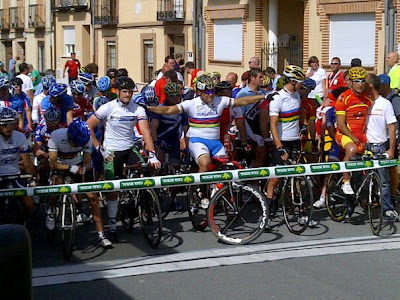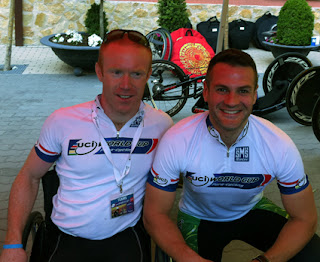When competing in a Time Trial or the Pursuit on the track, a winning strategy always involves setting the right pace. Start off too fast and you'll suffer badly and lose time at the end of the race. Too slow, and you'll give away valuable time.
But this post isn't about that kind of pace. Instead I want to share with you some of what has helped turn me into a winner; a much different kind of Pace.
When comparing myself with my fellow competitors, the one thing that stood out more than any other was that all the best amputee riders had one thing I did not: a purpose-built cycling leg. I have been riding and competing with a day-to-day leg; a wonder of technology that is both functional and technologically advanced – and reasonably life-like to look at. But heavy as a sack of hammers. If I was to put myself on equal footing (pardon the pun) with the other riders, I was going to have to get myself something special made up.
At the start of the year I approached a company in Manchester called Pace Rehabilitation (www.pacerehab.com) to see if they would be able to help me out. Amongst other things, they specialise in the design and construction of artificial limbs for proven and aspiring Paralympic athletes. In Paracycling alone, they have made limbs for two current World Champions (and a multiple Paralympic Champion). These folks really know their stuff.
Our initial discussions were based around where I currently stood in the World Rankings, and how much improvement a specialist leg could make to my prospects. At the time I was easily a top-10 rider in the world, but was going to need a big push to move up to the top of the list. However, I managed to convince them that I was a good prospect and they agreed to take me on board as one of their sponsored athletes.
Also at this time I was preparing to race in the Track World Championships. It soon became clear than any new leg would not be in ready in time for the competition, so I was going to have to use my existing leg. On the one hand it meant that my results would suffer, but on the other hand it has provided a good baseline for comparison for when the final leg is done and used in competition.
The design and construction of my leg was taken over by Pace's newest member of staff – Howard Woolley. Howard had just joined the Pace team and I was to be one of his first specialist projects. Howard and I met to discuss how I though the leg should look and function, and we quickly came to an agreement on how to proceed.
The first step in the construction process involves taking several moulds of my residual limb (stump). First a silicone sleeve is rolled onto the limb, followed by a layer of plastic wrap so that problem areas or weight supporting areas can be marked off in blue pencil. These marks get transferred to the inside of the cast and are used to fine tune the final socket.
 The leg is then wrapped in plaster (just like a broken leg would be). Once dry, the plaster cast is removed and is taken to the workshop to be converted into a positive mould. Several of these moulds were made – both over top of my stump and also over top of the sleeve that I would ultimately wear inside the finished leg (it protects my stump and keep the final leg in place).
The leg is then wrapped in plaster (just like a broken leg would be). Once dry, the plaster cast is removed and is taken to the workshop to be converted into a positive mould. Several of these moulds were made – both over top of my stump and also over top of the sleeve that I would ultimately wear inside the finished leg (it protects my stump and keep the final leg in place). A clear socket is then produced and attached to the lower part of the limb. The socket is clear so that you can see how my stump fits on the inside in case there are any problems and makes adjustments easier. The lower part of the limb at this stage was made from a strong foam-like material that would later be shaved down into the correct shape. From the photos you can see why we joked that it looked like a pair of 1970's flared jeans!
A clear socket is then produced and attached to the lower part of the limb. The socket is clear so that you can see how my stump fits on the inside in case there are any problems and makes adjustments easier. The lower part of the limb at this stage was made from a strong foam-like material that would later be shaved down into the correct shape. From the photos you can see why we joked that it looked like a pair of 1970's flared jeans! The next stage of production involved lots of fine-tuning. The shape of the new leg was slowly formed and constant changes to the length and fit were made. At each stage I had my bike in the lab on a static (turbo) trainer so that we could test out how it felt. Once a final working prototype was finished – I was able to take it out on the road for some trials. This required further adjustments to get it working perfectly and Howard was very patient in helping me make all the fine adjustments needed.
 |
| Silicone sleeve and release valve |
 |
| Early and final prototype |
The prototype was utilitarian and not much to look at. This is due to it being constantly cut and replastered together again. However, once the final adjustments had been made, Pace were able to make another version that would be the basis of the final leg. A photo of the final prototype was emailed to me in the morning for approval – and once I said I was happy – I was able to collect the final carbon leg that afternoon!
In the past few months that I have been using my new leg, I have skyrocketed up the World Rankings. I am beating the World Champion in my division with regularity and am now one of the top few riders in the world. I'm leading the World Cup and in September will be trying to win the World Championships. None of this would have been possible without the help of the good people at Pace. I have dedicated my first World Cup wins to them (In Australia earlier this year).
 |
| The final carbon leg with Howard Woolley at Pace |
My thanks go out to Howard Woolley, Nigel Firth (the technician who actually built the leg), Scott Richardson, Toby Carlsson and the entire team of people at Pace that have made this possible. If you are an aspiring amputee athlete, someone who just wants better service than the NHS offers or are looking for something different – these are the people to see.
Pace Rehabilitation (www.pacerehab.com)
Clinics
Tel: 0845 450 7357
Pace Rehabilitation Limited
Unit 1, Anglo Business Park
Asheridge Road
Chesham, Buckinghamshire
HP5 2QA
Unit 1, Anglo Business Park
Asheridge Road
Chesham, Buckinghamshire
HP5 2QA
Tel: 0845 450 7357








